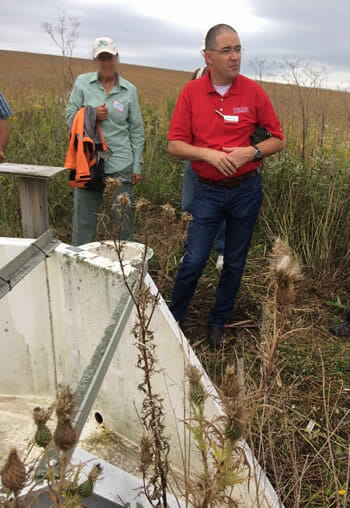

Matt Helmers from Iowa State University discusses STRIPS near a flume. Photo by Jane Hodgins, US Forest Service.
Newtown Square, PA, October 2, 2017 – A clean white plastic flume in an Iowa soybean field is testimony to a novel and possibly heretical idea: prairie plants, once plowed under by farmers growing corn and soybeans in the Midwest, yield benefits for farmers as well as the environment when integrated with rowcrops.
The flume is just one of many used on and near the Neal Smith National Wildlife Refuge east of Des Moines, Iowa, over the course of a decade of research called “Science-based Trials of Rowcrops Integrated with Prairie Strips,” or STRIPS. Without strips of prairie plants arching down the sloped field of soybeans, the flume would likely have held several inches of soil after a heavy rain.
The STRIPS research team is led by Iowa State University, the USDA Forest Service, Leopold Foundation for Sustainable Agriculture, and the U.S. Fish & Wildlife Service. A paper published today in the journal Proceedings of the National Academy of Sciences (PNAS) describes research quantifying the effects of integrating strips of native prairie species amid corn […]
Full article: Strips of prairie plants slow loss of soil, nutrients and water from ag fields while doubling biodiversity
Building Roots for a More Water Secure California
Can American soil be brought back to life?
Benefits of Groundwater Recharge Demonstrated in Lodi Vineyards
Diverse forests are stronger against drought
Plant roots go to extreme lengths to find water
Clean water is essential for life, yet millions of Americans unknowingly consume contaminants through their…
Human brains contain higher concentrations of microplastics than other organs, according to a new study, and the…
From the Office of the Governor: In anticipation of a multi-day, significant atmospheric river in Northern California,…
From Governor Newsom: Scientists, water managers, state leaders, and experts throughout the state are calling…
Photo: A harmful algal bloom in Milford Lake, Kansas, made the water appear bright green.…
An expanded plastic foam coffee cup is at a donut shop in Monterey Park, California.…